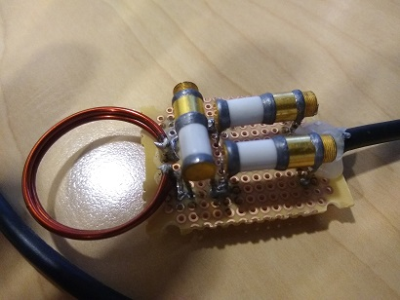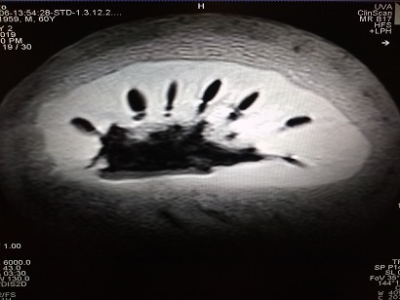Rene Jack Roy1
1UVA, charlottesville, VA, United States
Synopsis
The complexity and costs of MRI RF coil design seems out of reach for most non-physicists in the medical research field. To facilitate learning more about coil design and functionality, we have attempted to build a simple loop coil that can be used in small animal research.
Purpose
MR Imaging relies on the
use of RF resonator coils or probes, to transmit radio-frequencies within the
range of the imaging sample at a given magnetic field and in-turn collect
signal back from the sample at the appropriate time during imaging. With
the costs of commercially available coils ranging from 3000 US dollars to over
a quarter of a million dollars, is it feasible for a technologist to build a
simple loop coil, with a few select electrical components, that can be used for
MR Imaging in a non-clinical setting?Methods
A simple loop transmit
and receive coil will require three components: a loop of copper wire, three adjustable
capacitors and a connection (BNC) to the MRI system. A capacitance meter and a
RF Sweeper are used for both capacitor selection and for tuning of our coil and
will assist in helping our project to succeed.
The loop of wire is designed for both the size of the sample we will be
imaging and the thickness of the wire. The
Capacitors are glass, adjustable capacitors that we can install in parallel on the
wire loop, one on each end of the loop for tuning each side, and one installed
across the loop for balancing of the coil. Each capacitor has a range
that can be adjusted for our needs. Static capacitors can be added to
adjust the total capacitance of the coil to the desired frequency (300.4MhZ in
this case). For our project, we will be using just the loop of wire and
the three adjustable capacitors. A small circuit board was used to mount
all of the hardware for stability and location of soldering points. It is very important to keep excessive solder
from being a part of our coil.Results
We tested and tuned our coil on the Morris Frequency Response
Sweeper (Morris Instruments Inc.
Ottawa, Ont., Canada) and found that there was multiple
resonance frequency within a small range of our needed frequency at 7 Tesla.
After trial and error, we were able to get an adequate frequency at 300.4 MHz.
The first MRI image was acquired on a 7T Bruker Clinscan small animal MRI
system (Ettlingen, Germany) of a tomato to see what signal-to-noise we could acquire with the new
probe. The gradient echo image was adequate for demonstrating structure with
the tomato. T2 weighted images were then acquired along with T1 weighted
images. Most of the images showed adequate SNR as compared to other
commercially available RF coils of this size in our lab, but lacked the
uniformity of signal across the imaging plane.Conclusion
It was demonstrated that
a very simple MRI RF Coil could be constructed with just a few components in
our lab by a non-physics technologist. Other coils have been attempted
with some success and some failures. A Helmholtz Coil and a Saddle Coil
were developed next, each with their own hurdles. More intricate probe design
increases the complexity of tuning and balancing of the coil for optimal signal
to noise. More sophisticated equipment and knowledge is needed if other, more advanced
coil building is attempted.Acknowledgements
University of Virginia & Dr. Stuart Berr & Edwin BaldelomarReferences
No reference found.

